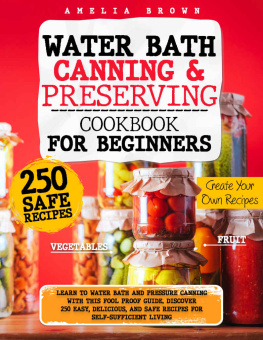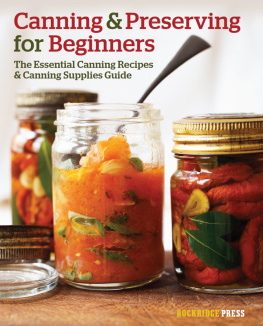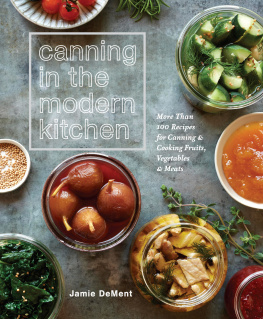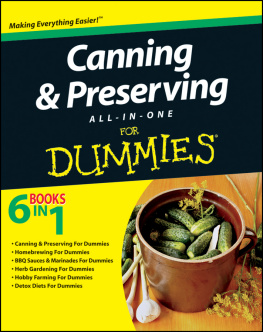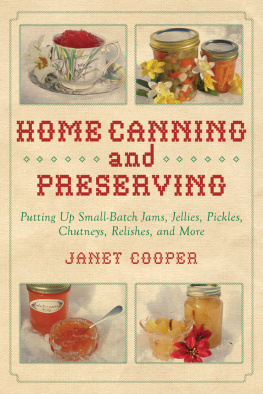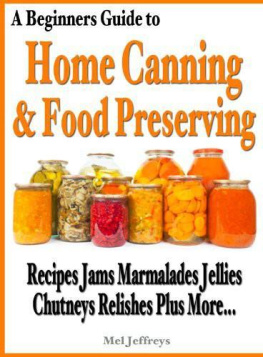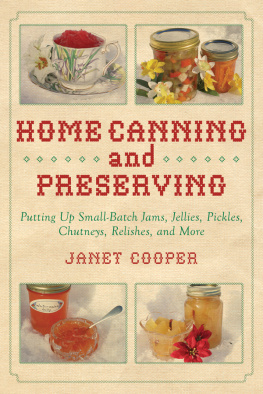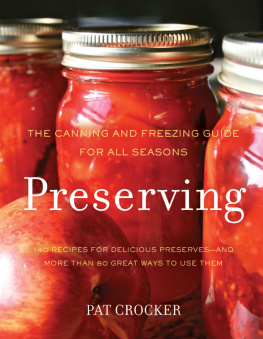APPENDIX: WHERE TO FIND THINGS
In their sequence, the letters C-E-S can give help to every householder in the United States on any matter of preserving food. They stand for Cooperative Extension Service, and mean that the U.S. Department of Agriculture is ready to instruct and advise anybody, anywhere, about any branch of food technology, including how to preserve food safely at home. Each state land-grant college or university has a USDA-CES, one of whose virtues is that it has no axe to grind. None. Except, of course, to sharpen our awareness of safety.
From People
The CES person who handles questions from the public used to be called a County Agent in Home Economics (hence our continual Ask your County Agent). Whoever answers your call to your local extension office will be able to direct you to a food scientist knowledgeable about home food preservation.
A sprawling metropolis may not have agents listed for every county it embraces geographically, but it is likely to have an Expanded Food and Nutrition Education Program (EFNEP) center, with branches in boroughs or settlement houses. Try them.
In the telephone directory your most likely listing will be plain Extension Service. Or look under your county agencies, and your state university. The Yellow Pages may list county agents under Vocational and Educational Guidance. You can also find your local extension service online. Go to www.csrees.usda.gov (USDA National Institute of Food and Agriculture) and then click on Local Extension Office.
More General
The best way to get USDA H&G (Home and Garden) bulletins is to access Index to USDA Home and Garden Bulletins at www.nal.usda.gov/ref/USDApubs/hgb.htm. The bulletins are searchable by title, by number, and by subject. Otherwise, contact your state or local library, land-grant university library, or other large research library.
In Canada, contact your provincial agriculture departments, through which materials may be available; their measurements are metric.
We refer often to the Morbidity and Mortality Weekly Report from the Centers for Disease Control in Atlanta, Georgia. It is available for free online at www.cdc.gov/mmwr.
Of the materials on nutrition, one of the best is Health and Nutrition Letter from Tufts University. It has depth and scholarship, and what seems to be unfailing good sense. To subscribe, go to www.tuftshealthletter.com/.
Chapter by Chapter
CHAPTER 1. WHAT IS IT?
The 20082009 sales figures for Jarden Homes brands were provided by Brenda Schmidt, brand manager for fresh-preserving products at the company, to Southern Maryland Online, October 9, 2009, http://somd.com/news/headlines/2009/10614.shtml.
The six methods of food preservation described in the Master Food Preserver workbook of the University of California, Davis (led by Kathryn Boor, 1987), are credited to the University of Illinois MFP program manual.
CHAPTER 2: WHY FOODS SPOIL
USDA H&G Bulletin No. 162, Keeping Food Safe to Eat, available online (see above for link).
The introductions to preserving food at home are in all accredited manuals.
Several food safety publications are available from the Federal Citizen Information Center, Pueblo, Colorado. Most of these publications are available for free online, at http://www.pueblo.gsa.gov/Epubs/epubFO.htm. Or call 1-888-878-3256.
CHAPTER 3: ALTITUDE AND METRICS
Altitude. The Colorado State University pamphlets are especially good for their simplicity and quickness, among them: Pamphlet 41, High Altitude Food Preparation (Revised 1977), by Dr. Pat Kendall, Extension Specialist, Food Science and Nutrition, Colorado State University, Fort Collins 80523. Pamphlet 41 is available online: http://www.gunnison.colostate.edu/hh/hh_docs/highaltfdprep.pdf.
Also extremely valuable for their sensible recognition of the problems out in the field are the New Mexico State University, Las Cruces bulletins, especially Guide E-215: High-Altitude Cooking, which is available online at http://aces.nmsu.edu/pubs/_e/.
Metrics. Where to begin? Most recently published general-purpose cookbooks include metric conversion charts. Also, the Pueblo Information Center (see above) lists government publications.
CHAPTER 5: COMMON INGREDIENTS AND HOW TO USE THEM
Artificial sweeteners. From time to time the Centers for Disease Control include items on artificial sweeteners; see the Morbidity and Mortality Weekly Report (the link to MMWR is listed earlier).
Other addresses for common ingredients: Morton Salt Consumer Products, 123 North Wacker Drive, Chicago, Illinois 60606, or www.mortonsalt.com. Mortons online store offers a range of salt products useful in home preserving. For information on food-grade chemicals and other substances, Fisher Scientific Company, http://www.fishersci.com/wps/portal/HOME.
For thickening, a wonderful addition to everyday kitchens is a modified cornstarch called ClearJel by its maker, National Starch and Chemical Company. Supplied to the frozen food industry among other commercial users, it will not break down under prolonged heat processing, and it will not get opaque or chunky but become pleasantly firm. Its a prime ingredient in the Pie Fillings in Chapter 12. ClearJel is not sold in supermarkets but is available at many online stores that sell preserving and/or baking products.
CHAPTER 6: THE CANNING METHODS
The most thorough general reference book is, of course, The Complete Guide to Home Canning, 2006 revision, which not only covers canning but all other common methods of home preservation, such as pickling and dehydrating. It can be accessed at: http://www.uga.edu/nchfp/publications/publications_usda.html.
Jarden Home Brands, makers of Ball and Kerr canning jars in the U.S. and Bernardin canning jars in Canada, offers many recipes. Call 1-800-240-3340 or go to http://www.homecanning.com.
So Easy to Preserve by Susan Reynolds, et al., Cooperative Extension Service, the University of Georgia (1984)a favorite with PFB because of its style and organization. Now in its fifth edition, the book can be ordered through http://www.uga.edu/setp/.
Worthwhile pamphlets/bulletins start with Dr. Pat Kendalls publications on high-altitude canning fruits and vegetables, from Colorado State University, Fort Collins, Colorado 80523, cited earlier. Notably sensible.
Mirro Company, Manitowoc, Wisconsin 54220, makes Pressure Canners, as well as pressure cookers; their entire line is deadweight gauges. For information on their products, go to www.wearever.com.
National Presto Industries makes both Pressure Canners and pressure cookers. Prestos current line of dial-gauge Pressure Canners is sold on its website. Prestos weighted-gauge canners are available only through Walmart. The Presto people have helped fund much research, including the 15-psig research at the University of Minnesota, and work in home-canning of seafood. Contact them at www.gopresto.com.
Ball and Kerr have long been the most popular canning jars in the United States. Both are now manufactured by Jarden Home Brands (formerly Alltrista). The caps, lids, and rings of either brand can be used on both brands of jars. Also now part of Jarden Home Brands, Bernardin makes jars in Canada.
Freund Container & Supply Company has a wide selection of cans (and sells in less than giant carloads). They also have a manually operated can sealer. For their products, go to their website at www.freundcontainer.com or phone 1-800-363-9822.
CHAPTERS 712: CANNING SPECIFIC FOODS


